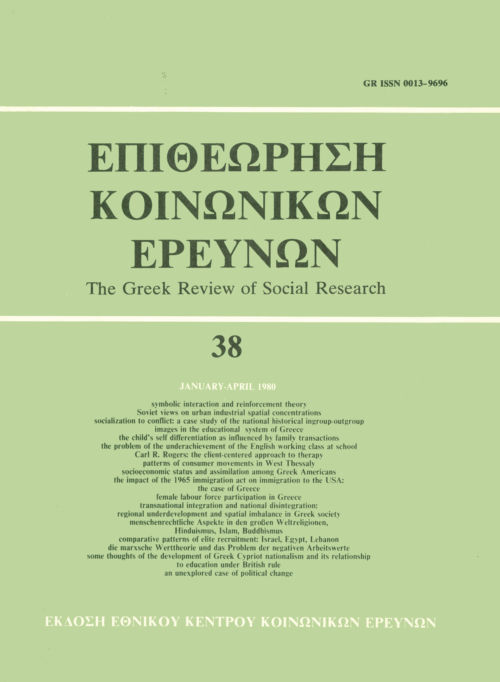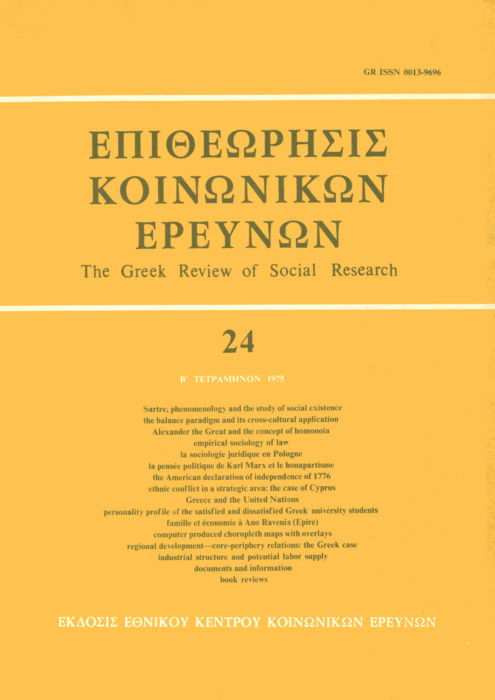Transnational intergration and national disitegration: Regional underdevelopment and spatial imbalance in Greek society
Abstract
An attempt has been made to demonstrate that Greek space is
characterised by an inter sectoral, inter regional and intra-regional
duality as well as by a highly disintegrated economic structure. The
above evidence was used to contest the assumptions of the classical
location theories of Weber, Isard, Christaller, Lösch and Alonso, who
emphasised the existence of a homogeneous and balanced
distribution of physical and human resources in space; and the
assumptions of the theory of inter\regional flows of factor
movements of Lutz and Richardson, who attributed to these flows
virtuous effects in relation to inter regional imbalance.
A further conclusion drawn from the historical development of the
Greek socio-economic spatial structure was that until 1922 there
were no definite national boundaries. Consequently, the conventional
disequilibrium models of regional distribution of resources,
which tend to abstract national space from the wider international
context, would impede identification of the relation between what we
have called transnational integration, national and regional
disintegration of socio-economic structures in Greece. For such
reasons it was claimed that the models of centre-periphery and
dependency theories, suggested by Friedmann, Frank, Amin and
Sunkel, would prove more relevant for analysing Greek soci»
economic space.
By employing these models, we have demonstrated that urban and
regional polarisation in the modern Greek State was caused by a new
system of authority-dependency relations which was grafted onto a
pre-capitalist «traditional» system of society, and which radically
transformed the spatial organization of the existing urban system.
The new national élites, in close partnership with foreign capital,
amassed a growing proportion of the nation’s wealth. Moreover, the
new import-substitution industrialisation policies implemented by the
élites contributed to the growing primacy of the Athens region,
where processes of «circular and cumulative causation» sustained accelerated
growth. Thus, a vicious circle of cumulative disequilibrium
was set in motion, which produced a type of urbanisaton without industrialisation
with its concomitant phenomena of «involution» and
«ruralisation».
The conclusions of our research pointed to a structural
heterogeneity that suggests five different levels of technology,
organization and social relationships within the major economic sectors
of Greece's socio-economic formation.
Article Details
- How to Cite
-
Evangelinides, M. (1980). Transnational intergration and national disitegration: Regional underdevelopment and spatial imbalance in Greek society. The Greek Review of Social Research, 38, 121–140. https://doi.org/10.12681/grsr.267
- Issue
- 1980: 38
- Section
- Articles

This work is licensed under a Creative Commons Attribution-NonCommercial 4.0 International License.
Authors who publish with this journal agree to the following terms:
- Authors retain copyright and grant the journal right of first publication with the work simultaneously licensed under a Creative Commons Attribution Non-Commercial License that allows others to share the work with an acknowledgement of the work's authorship and initial publication in this journal.
- Authors are able to enter into separate, additional contractual arrangements for the non-exclusive distribution of the journal's published version of the work (e.g. post it to an institutional repository or publish it in a book), with an acknowledgement of its initial publication in this journal.
- Authors are permitted and encouraged to post their work online (preferably in institutional repositories or on their website) prior to and during the submission process, as it can lead to productive exchanges, as well as earlier and greater citation of published work (See The Effect of Open Access).




